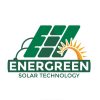
We are excited to announce that Energreen Solar Technology (Bangladesh), in collaboration with Energreen Technologies Pte Ltd (Singapore), has taken a significant step forward in sustainable innovation.
As part of our mission to transform the way energy is produced and consumed, we are introducing advanced solar architectural design solutions—including Building-Integrated Photovoltaics (BIPV) and Building-Applied Photovoltaics (BAPV)—now available in Bangladesh.
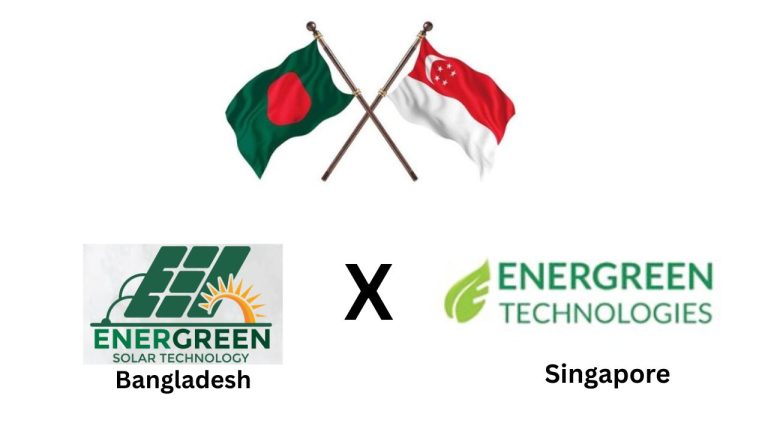
Building-Integrated Photovoltaics (BIPV):
The Future of Solar Architecture
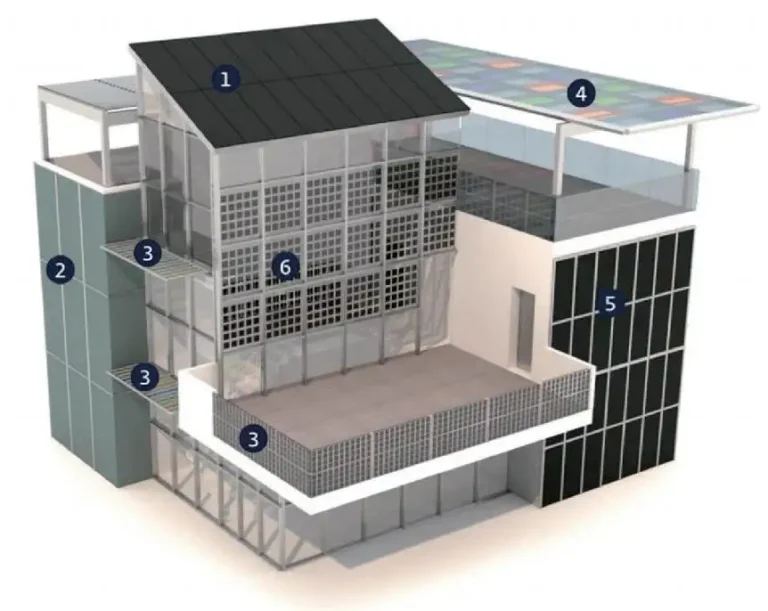
In today’s world, sustainability and aesthetics go hand in hand. One of the most innovative solutions bridging these two needs is Building-Integrated Photovoltaics (BIPV). Unlike traditional solar systems, which are mounted onto rooftops or structures, BIPV technology integrates solar panels directly into the building envelope — including facades, roofs, skylights, and even windows.
What Is BIPV
Building-Applied Photovoltaics (BAPV) refers to solar photovoltaic modules that are installed on the exterior surfaces of buildings — such as rooftops, facades, balconies, or shading devices — without altering the original building envelope. These panels are usually mounted using support structures and can be installed on both new constructions and existing buildings as part of a retrofit project.
This approach makes BAPV one of the most common and practical applications of solar energy in urban environments.
Coloured and Designer Solar Panels
Modern solar technology is no longer limited to traditional blue or black panels. Coloured and designer solar panels allow homeowners and architects to integrate solar energy seamlessly into the aesthetic of a building. These panels are available in a variety of shades, patterns, and textures, enabling them to match or complement roof tiles, facades, and other building materials.
Stone-Design Panels replicate natural stone surfaces, giving rooftops and walls a textured, earthy appearance while still generating electricity. They are ideal for homes seeking a natural, rustic look or for areas where conventional panels might clash with architectural style. Wood-Design Panels mimic timber finishes, offering warmth and elegance to modern or traditional homes. These panels are particularly suited for facades, pergolas, or roof sections where the visual appeal is as important as energy production.
Designing a House with Designer Panels
Using coloured and designer panels opens up creative possibilities in residential architecture. For example:
Rooftop Integration: Stone or wood-design panels can replace traditional roof tiles entirely, giving the house a unified and elegant look. Coloured panels can be arranged in patterns or gradients to enhance visual appeal.
Facade Applications: Designer panels can be installed on exterior walls, acting as both cladding and energy-generating surfaces. This approach works especially well for modern homes with large vertical surfaces.
Pergolas and Carports: Wood or stone-style solar panels can cover outdoor structures, creating shaded areas that generate electricity while blending seamlessly with the home’s overall design.
Accent Features: Coloured panels can be used selectively as decorative elements on balconies, window shades, or roof edges, adding artistic flair without compromising solar output.
By integrating these designer panels thoughtfully, homeowners can combine energy efficiency with style, making the house both environmentally sustainable and visually striking. These panels provide a unique opportunity to design homes that are eco-friendly, modern, and customized to personal taste, while still harnessing the power of the sun.
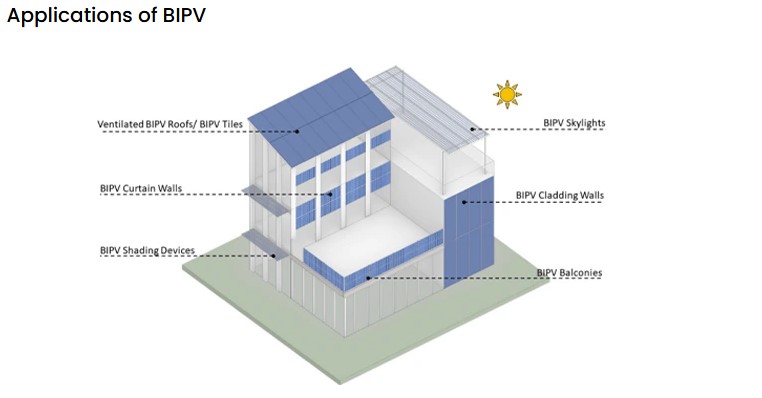
Types Of BIPV Applications
1.PV Roof Panel
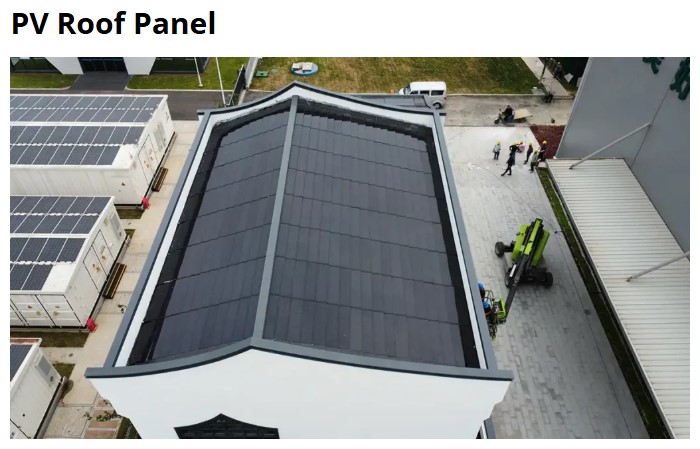
A PV roof panel is a solar photovoltaic module installed on rooftops to convert sunlight into electricity for homes, businesses, or industries. These panels are typically made of high-efficiency monocrystalline or polycrystalline cells and are mounted on existing roofs to make use of unused space. PV roof panels are durable, cost-effective, and provide clean energy for over 25 years with minimal maintenance. They not only help reduce electricity bills but also lower carbon emissions, making them an ideal choice for sustainable and energy-independent living.
Benefits of PV Roof Panels
Clean Energy – Converts sunlight into usable electricity.
Cost Savings – Reduces or eliminates electricity bills.
Durability – Panels last 25+ years with minimal maintenance.
2.Thin-Film Solar Cell
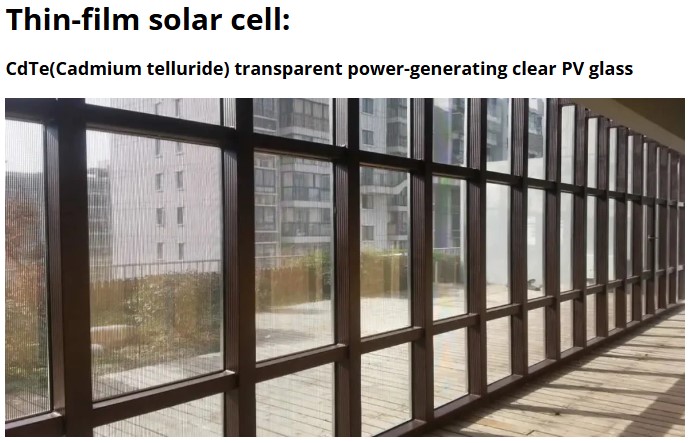
Thin-film solar cells are a type of photovoltaic (PV) technology where very thin layers of semiconductor materials are deposited on a substrate such as glass, plastic, or metal. Unlike conventional crystalline silicon panels, thin-film cells are lightweight, flexible, and can be integrated into a variety of surfaces, including roofs, facades, and even windows.
Key Features
Lightweight & Flexible – Can be applied to curved or unconventional surfaces.
Aesthetically Versatile – Ideal for building-integrated applications (BIPV).
Lower Cost of Materials – Uses less semiconductor material than traditional panels.
Performance in Low Light – Works better in diffuse sunlight or cloudy conditions.
3. PV Curtain Wall Facade
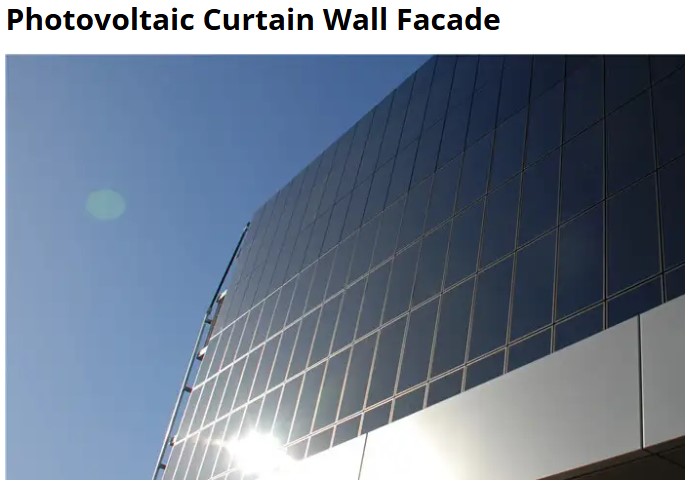
A PV Curtain Wall Facade is a modern building solution that integrates solar panels into the exterior glass or cladding of a structure, allowing it to function both as an architectural element and a clean energy generator. These facades combine aesthetics with performance, offering transparent or semi-transparent solar glass that produces electricity while maintaining natural daylight. Widely used in high-rise buildings, offices, and smart city projects, PV curtain walls improve energy efficiency, reduce carbon footprint, and support green building certifications—all while giving a sleek, modern look to the architecture.
4. Transparent PV Curtain Wall/ Roof Tile
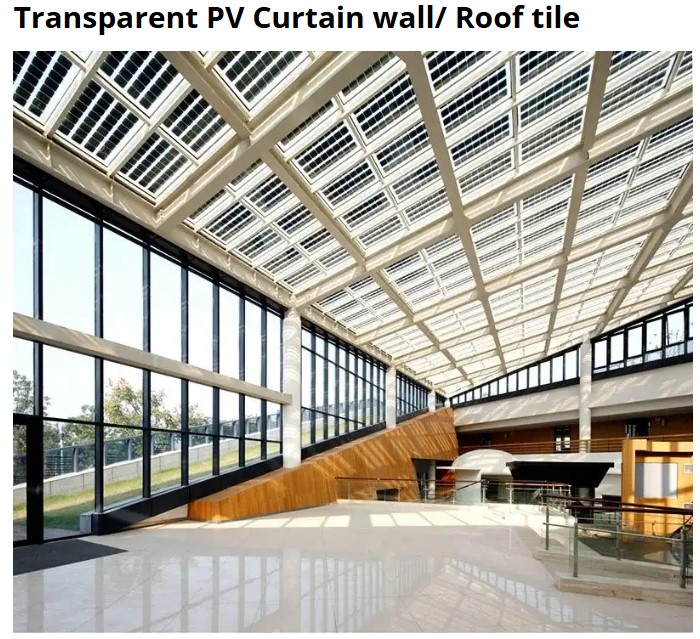
A Transparent PV Curtain Wall or Roof Tile is an innovative solar solution that combines power generation with modern architectural design. Made with semi-transparent photovoltaic glass, these systems allow natural daylight to pass through while simultaneously producing clean electricity. They are ideal for facades, skylights, and rooftops in commercial buildings, offices, and smart homes. Beyond energy savings, transparent PV elements enhance aesthetics, provide thermal insulation, and support sustainable building certifications—turning every surface into a functional, energy-producing feature.
Building Applied Photovoltaic (BAPV)
As the world moves toward cleaner and more sustainable energy solutions, solar power has become a leading technology in the renewable sector. One of the most practical and widely adopted methods of harnessing solar energy in the built environment is Building-Applied Photovoltaics (BAPV). Unlike BIPV (Building-Integrated Photovoltaics), which replaces conventional building materials, BAPV systems are applied onto existing building structures as an additional layer, making them cost-effective and highly flexible.Lorem ipsum dolor sit amet, consectetur adipiscing elit. Ut elit tellus, luctus nec ullamcorper mattis, pulvinar dapibus leo.
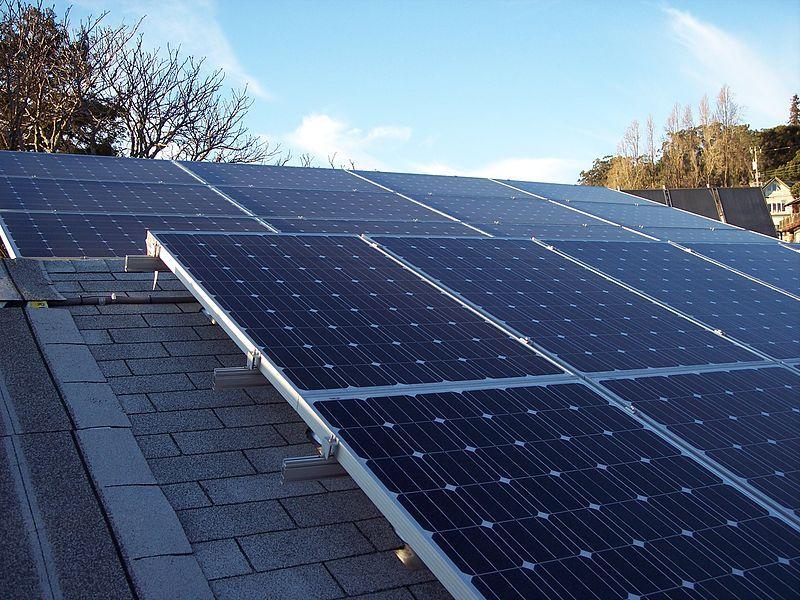
What is BAPV?
Building-Applied Photovoltaics (BAPV) refers to solar photovoltaic modules that are installed on the exterior surfaces of buildings — such as rooftops, facades, balconies, or shading devices — without altering the original building envelope. These panels are usually mounted using support structures and can be installed on both new constructions and existing buildings as part of a retrofit project.
Difference Between BIPV/ BAPV
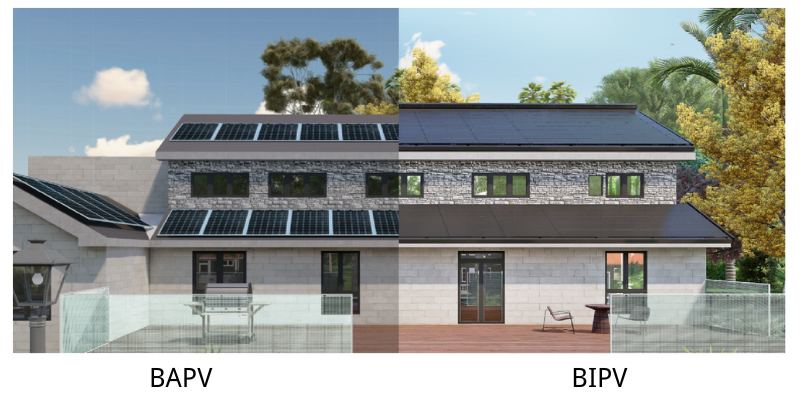
Building-Integrated Photovoltaics (BIPV)
Building-Integrated Photovoltaics (BIPV) refers to solar technology that is built directly into the structure of a building, replacing traditional materials like glass, roof tiles, or wall cladding with photovoltaic elements. In this approach, the solar panels are not just an add-on but form part of the building envelope itself, blending aesthetics with functionality. BIPV offers a modern and seamless appearance while turning building surfaces into active energy generators. Although this solution provides long-term value and architectural elegance, it generally requires higher upfront investment and specialized design compared to conventional solar systems.
Building-Applied Photovoltaics (BAPV)
Building-Applied Photovoltaics (BAPV), in contrast, involves the installation of solar panels onto existing building structures without replacing the original materials. Typically mounted on rooftops, facades, or other available surfaces, BAPV is one of the most widely used methods for adopting solar power in residential, commercial, and industrial buildings. It is cost-effective, relatively easy to install, and suitable for retrofitting older properties, making it a practical option for large-scale deployment. While BAPV may not achieve the same level of architectural integration as BIPV, it remains the more accessible and widely adopted solution for generating clean energy in today’s built environment.
In short:
BIPV = integrated into the building material (stylish, modern, higher cost).
BAPV = applied onto the building surface (practical, affordable, easier to adopt).
Power Generation Quality: BIPV vs. BAPV vs. Conventional PV Panels
When it comes to electricity generation, conventional PV panels generally deliver the highest efficiency, since they are designed solely for performance and installed at the best tilt and orientation to capture maximum sunlight. These panels typically achieve higher conversion rates and remain the benchmark for solar output.
BAPV systems, which use similar crystalline silicon modules mounted on rooftops or facades, often produce electricity at nearly the same efficiency as normal panels. The only difference is that mounting conditions, roof angle, and shading can slightly reduce performance compared to ground-mounted or optimally placed systems. Overall, BAPV remains reliable and close in generation quality to standard solar installations.
On the other hand, BIPV systems usually have somewhat lower efficiency, since the solar elements are integrated into building materials such as glass or tiles, where ventilation and tilt angles are less ideal. Semi-transparent or colored BIPV glass can also reduce sunlight absorption, further lowering output compared to conventional panels. While BIPV adds significant value in terms of aesthetics and multifunctional design, its generation capacity is typically lower per square meter than both BAPV and standard PV modules.
Durability of BIPV and BAPV
Building-Integrated Photovoltaics (BIPV) and Building-Applied Photovoltaics (BAPV) are designed for long-term performance, but their durability depends on materials, installation, and environmental exposure.
BIPV systems are highly durable because the solar modules are integrated directly into the building envelope, often replacing roof tiles, glass, or cladding. This integration protects the panels from mechanical damage, wind, and external stress, while also reducing wear from mounting structures. High-quality BIPV systems can last 25 to 30 years or more, maintaining both structural integrity and energy production over time. Proper design and installation are key to preventing leaks, thermal stress, or panel degradation.
BAPV systems are also robust, as they use conventional PV panels mounted on rooftops or walls. Their durability is influenced by the strength of the mounting structures and exposure to wind, snow, or debris. BAPV panels are generally easier to inspect, maintain, and replace if needed. Like BIPV, high-quality BAPV installations can last 25 years or more, but panels exposed on flat rooftops or less-protected areas may require more frequent maintenance to ensure longevity.
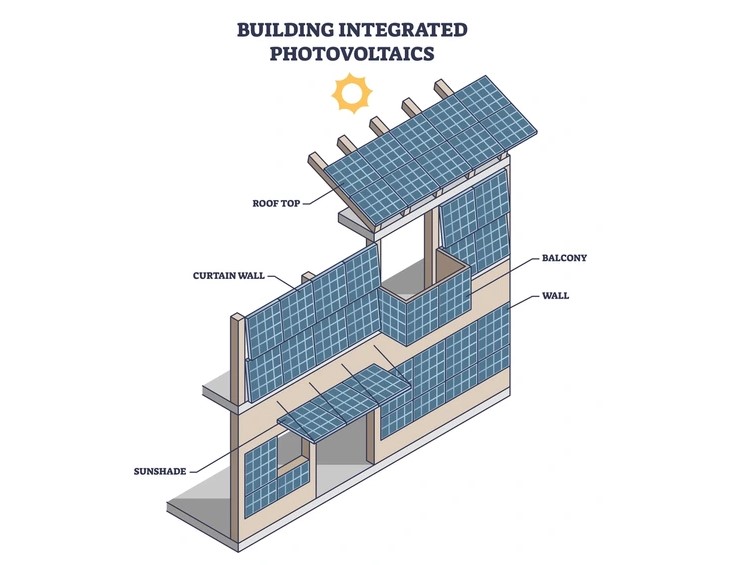
Why Choose BIPV or BAPV?
Building-Integrated Photovoltaics (BIPV) and Building-Applied Photovoltaics (BAPV) both offer unique advantages for homeowners, architects, and developers looking to incorporate solar energy into buildings. Choosing between them depends on the goals of the project, budget, and design preferences.
BIPV is ideal for those who want a seamless, aesthetically integrated solution. By replacing conventional building materials like roof tiles, glass facades, or cladding with photovoltaic elements, BIPV combines functionality and design, turning every building surface into an energy generator. It enhances architectural appeal, supports green building certifications, and adds long-term value, making it perfect for modern, high-end constructions or projects emphasizing visual elegance.
BAPV, in contrast, is the most practical and cost-effective option. These solar panels are mounted on existing rooftops, walls, or shading structures without replacing building materials, making installation faster, easier, and suitable for retrofitting older buildings. BAPV delivers reliable energy generation with lower upfront costs, providing an efficient and flexible way to adopt solar technology while maintaining the existing structure.
Ultimately, BIPV is chosen for design integration and innovation, while BAPV is preferred for practicality, affordability, and ease of installation. Both systems contribute to sustainability, reduce electricity costs, and support the transition to renewable energy.

Why We Excel in BIPV and BAPV
Our expertise in BIPV and BAPV systems sets us apart because we combine technical mastery, design innovation, and practical implementation. Backed by our collaboration with Energreen Technologies, Singapore, we have access to world-class solar solutions, cutting-edge materials, and advanced installation techniques.
In BIPV projects, we focus on seamlessly integrating solar panels into roofs, facades, and cladding without compromising aesthetics or structural integrity. Our experience allows us to deliver high-quality, durable, and visually appealing solutions that enhance building design while generating clean energy.
For BAPV systems, we leverage practical strategies to retrofit existing buildings efficiently, ensuring maximum energy generation with cost-effective installation. By carefully analyzing roof orientation, shading, and load-bearing capacity, we optimize panel placement to deliver superior performance.
In short, our combination of technical expertise, innovative solutions, and high-quality materials ensures that whether it’s BIPV or BAPV, we provide efficient, durable, and visually striking solar solutions that meet the highest global standards and client expectations.
